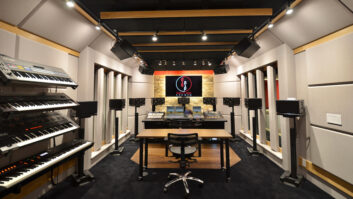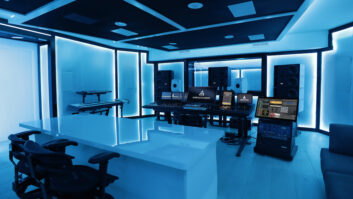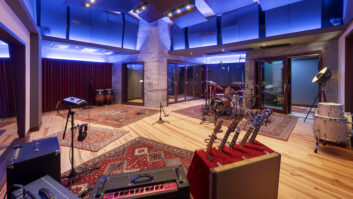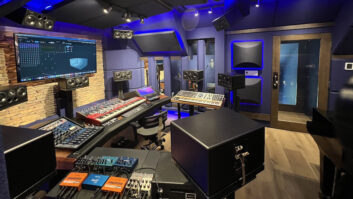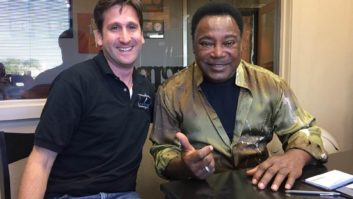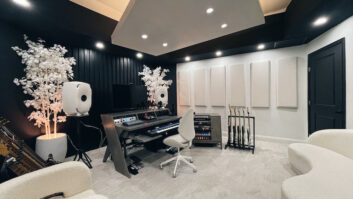When I approached Rodney and Linda Hall a few months after Rick Hall’s untimely passing with the prospect of refurbishing and renovating FAME Recording Studios’ landmark Studio B, I was surprised at their receptiveness and enthusiasm.
Studio B is not only a historic facility, but it has also been a launchpad for countless iconic careers, as well as being hands-down one of the finest live rooms I’ve ever had the pleasure to lay down tracks in. Modernizing the studio without sacrificing its unique qualities would be a monumental undertaking that would have to be performed with the greatest of care.
Studio Showcase: FAME Recording Studios
With a reverence for the culture created in that room, and an eye toward relevance and contemporary production values, Rodney and I sought to create a home for both the old and the new. What we did create, in our eyes, is something beyond our hopes and expectations.
Rodney’s father, music legend/super-producer Rick Hall, built Studio B in 1967 to accommodate scheduling overflow from the booked-solid Studio A at FAME Recording Studios. It wasn’t long before Studio B was adding its own stamp on the home of the Muscle Shoals sound.
Early in its life, Studio B housed the nascent jam sessions for what would become the Allman Brothers Band. Jimi Hendrix recorded in Studio B. Many of the great horn arrangements for legendary FAME recordings were put down in Studio B, along with classics like “Hey Joe” by Wilson Pickett, and “Greenwood, Mississippi” by Little Richard. So, we’re talking some real intimidating history to be playing around with.
I had experienced the acoustic beauty of Studio B for myself back in 2018 when cutting vocals with Whitney Woerz for my record label, 600 Volt/Sony. Although the equipment in the control room wasn’t top-of-the-line, and the control room itself was small and needed to be refreshed, I was getting some of the best vocal sounds I’d ever recorded. I knew—and Rodney and Linda knew—that there was glory in this room that needed to be resurrected, but we also knew that every bit of the renovation process had to be done with the greatest care, in order to preserve the rich sound that makes FAME FAME.
After deciding on everything that needed to be done to modernize Studio B, Rodney and I were soon pulling down walls to widen the size of the control room.
It was like an archeology dig, exposing surfaces that hadn’t seen light in over fifty years. As we dug deeper, we became aware of a lot of smart design elements that we used to our advantage, and the room now arguably competes with some of the best modern acoustics, benefiting from a design found nowhere else in the world.
Its singular flying-bass-trap and LEDE configuration offers near-perfect room decay times and superb localization and staging. We restored the original Urei 813 monitors and powered them with custom hand-built Emotiva mono-block amplification. The room-within-a-room design has been complimented by all Mogami wiring, discreet tech power with fully separated ground isolation and near silent HVAC ducting.
I contacted Paul Savasta at Odyssey Pro Sound to broker the purchase of a vintage Solid State Logic 6056E 56-channel console from Stevie Ray Vaughan’s studio, where it recorded three of Vaughan’s studio albums (Soul To Soul, The Sky Is Crying, Live Alive), along with projects by Destiny’s Child, ZZ Top, Phil Collins, Leon Russell, and Erykha Badu, to name but a few. The SSL is now operating with an Atomic Instruments custom power supply, as well as a THD-Labs Tangerine dedicated automation computer.
FAME Recording Studios is also proud to welcome home—returning from the Alabama Music Hall of Fame—Studio B’s original, hand-built Universal Audio 12 channel console, custom made for Rick Hall by Urei founder Bill Putnam, inventor of the 1176, LA-2A, as well as a host of other classic equipment standards. This historic recording treasure will serve as a side car for the SSL.
Of course, the beauty in a recording studio isn’t simply about equipment and technology. A great space needs to foster creativity and kinship. Musicians, engineers, and producers need to be able to step away from the action, and let the ideas incubate and grow. To provide a comfortable place to relax and create, we repurposed FAME’s former studio tape library and converted it into the new Studio B lounge, a private and personal space exclusively for Studio B clients. This lounge, accessed from the control room, has been renovated with memorabilia from FAME’s historic past, and still houses original master recordings of Otis Redding, Wilson Pickett and Aretha Franklin. These artifacts, documentation and photographs spotlight a one-of-a-kind musical legacy, a legacy that continues to grow with every artist that walks through FAME’s hallowed doorways.
Mission Number One for us was to keep FAME Recording Studios’ sound and legacy intact. However, in order to thrive and survive, we needed FAME to grow and evolve. After months of construction and renovations, I am proud to say that the magic, the heart-pounding sound, is still there. FAME is still FAME. And then some.
Born and raised in New York City, Glenn Rosenstein began his music career at the legendary Power Station Recording Studio, assisting alongside some of the best and brightest producers, engineers and artists in the business. Honing his craft at New York’s historic Sigma Sound Studios, Rosenstein became a sought-after mixer and remix engineer, creating work for such artists as U2, Madonna, Talking Heads, The Ramones, Lisa Lisa & Cult Jam, James Brown, Miles Davis and others. His music production and mixes continue to be visible and diverse, finding him working with artists ranging from Whitney Woerz, Carly Simon and Andrew St. James to James Taylor, The Mercy Trigger, Wes Sheffield and Bif Naked. As a producer, mixer, and engineer, Rosenstein’s projects have won 3 Grammy Awards, garnered five Grammy nominations, and have won both an Oscar and a Golden Globe Award. His work is responsible for record sales well in excess of 300 million units. His music production and mixing credits for film and television include The Sopranos, Celebrity Circus, The Last Emperor, Blown Away, Married To The Mob, Charmed, Beverly Hills 90210, All My Children and Buffy The Vampire Slayer. As both songwriter and producer, his work with reggae artist Snow led to a chart-topping single in Canada. In addition, he oversaw production of a landmark multi-DVD project for Saturday Night Live’s 25th Anniversary, producing the surround remixes and audio for 60 unique music performances and 60 musical comedic sketches. This project featured the live performances of Mariah Carey, Sting, Aretha Franklin, Metallica, Nirvana, Paul McCartney, Snoop Dogg, Paul Simon, Alanis Morissette, James Brown and Bruce Springsteen, to name but a few.

